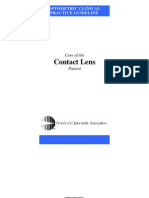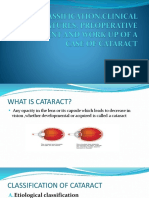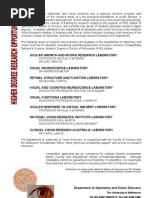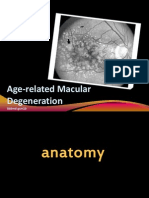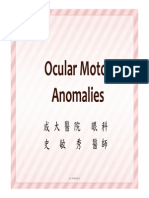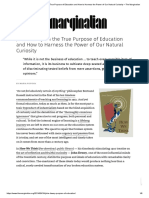Essential Components of Primary Eye Care: Editorial
Essential Components of Primary Eye Care: Editorial
Uploaded by
AreenaCopyright:
Available Formats
Essential Components of Primary Eye Care: Editorial
Essential Components of Primary Eye Care: Editorial
Uploaded by
AreenaOriginal Description:
Original Title
Copyright
Available Formats
Share this document
Did you find this document useful?
Is this content inappropriate?
Copyright:
Available Formats
Essential Components of Primary Eye Care: Editorial
Essential Components of Primary Eye Care: Editorial
Uploaded by
AreenaCopyright:
Available Formats
Editorial
CONCEPTS OF PRIMARY EYE CARE
Eye Diseases Activity Who Can Be Involved
Teachers / Community Leaders
TRACHOMA PRIMARY PREVENTION Traditional Birth Attendants / Healers
VITAMIN A DEFICIENCY – in the community through PHC Primary Health Care Workers
ONCHOCERCIASIS Community Based Rehabilitation Workers
Focal diseases SECONDAY PREVENTION
Start in childhood – identify and treat in the community General Physicians
CATARACT Community Based Rehabilitation Workers
GLAUCOMA INDENTIFY AND REFER Primary Health Care Workers
(DIABETIC RETINOPATHY) Optometrists
Affect mainly adults FOR TREATMENT
Occur everywhere General Physicians
ACUTE RED EYE DIAGNOSE AND TREAT Primary Health Care Workers
Affects any age or DIAGNOSE AND REFER General Physicians
Occurs everywhere
Primary Eye Care
Clinical Service Component
Essential Components of Community diagnosis precedes primary
Primary Eye Care eye care activities and may give a different
outlook regarding eye health of individual
communities. This leads to adapted service
K Konyama 3. Vulnerability: V – availability of components, according to social and eco-
effective means of intervention.
MD PhD MPH nomic standards, as well as the available
4. Cost: C – resources needed for control system of health care. Essential elements,
Department of Ophthalmology
programmes. therefore, vary accordingly and may not
Juntendo University School of Medicine
Tokyo, Japan Priority may be known from: 2 include only the well known major blind-
Priority = (M × I × V) / C ing conditions. In addition, common eye
Introduction disorders found in individual communities
This is a simple model illustrating scien- require simple but adequate services
rimary eye care activities cover the
P following two areas of community
tific application in planning. It should
avoid instinctive preferences based only on WHO GUIDELINES FOR
health services.1 clinical experiences. PRIMARY EYE CARE
1. Clinical service component I Conditions to be recognised and
Service Components of Primary Eye treated by a trained primary health care
2. Eye health protection and promotion Care worker
component • Conjunctivitis and lid infections
Service in the community should be suffi-
Acute conjunctivitis
It is most important that most activities are ciently comprehensive to cover aspects of Ophthalmia neonatorum
initiated and sustained by community primary, secondary and tertiary prevention Trachoma
members themselves. The eye sector helps targeted for all community members Allergic and irritative conjunctivitis
the community, complementing what they whether they have or do not have eye prob- Lid lesions, e.g., stye and chalazion
lems. This is the point where community- • Trauma
do in their day-by-day activities.
based care differs from hospital-based Subconjunctival haemorrhages
The essential elements of primary eye Superficial foreign body
care should be determined by careful study services.
Blunt trauma
providing a ‘community diagnosis’, based It begins with an understanding of any • Blinding malnutrition
on an epidemiological approach. The study community at a point in time, and recog-
nises three groups of people in need of eye 2 Conditions to be recognised and
will list community eye problems in order referred after treatment has been
of priority. To this end the study should care screening: initiated
be planned to include the following infor- 1. Healthy group. • Corneal ulcers
mation: 2. The group with certain eye diseases or • Lacerating or perforating injuries of the
problems. eyeball
1. Magnitude: M – prevalence and inci- • Lid lacerations
dence, given by the number of community 3. The group at risk of eye diseases or
• Entropion/trichiasis
members suffering from particular con- problems. • Burns: chemical, thermal
ditions and new cases expected in a given Hence, services should not only be clini-
3 Conditions that should be recognised
period of time. cal, but equal or more attention is needed and referred for treatment
2. Implication: I – social and economic for people without disease. Primary eye • Painful red eye with visual loss
consequences from the condition, given in care, therefore, covers the whole range • Cataract
terms of expenditures, work loss, absence of eye health care for all community • Pterygium
from school, etc. members. • Visual loss; <6/18 in either eye
Community Eye Health Vol 11 No. 26 1998 19
Primary Eye Care
particular to that community. Decisions,
therefore, should be made, not according
to clinical interest, but from a public health
point ofview. Conditions which are simple
to prevent and manage and common to
many communities are included in primary
eye care services. This is true, for
example, for reading problems among the
elderly, and seasonal conjunctivitis may
well need equal attention. In general, the
World Health Organization provides the
guidelines given on page 19.3
Based on the WHO guidelines and
available data, the model initiated in Thai-
land, which started primary eye care in
1981, integrated the following conditions
into primary health care:
Discussion on the common eye diseases for community volunteers: mostly teachers,
• Cataract (age-related/‘senile’ type) traditional healers and senior students. An ICEH slide set is being used. Vivekananda
• Trachoma and its late complications Mission Asram, West Bengal, India Photo: Anup, New Stylo, Chaitanyapur
Table 1: Primary Eye Care Integration Matrix
PHC Health Family Food & Safe water Extended Essential Control of Care for
education planning & nutrition & basic programme of drugs local mild
PEC MCH sanitation immunisation endemic ailments
(**) diseases (‘simple’
(****) treatment)
Cataract +++ + for ++ +++ +++
Surgical ++ congenital NA NA NA post operation case finding, case finding,
Non-surgical cataract care referral & referral &
community care community care
Trachoma +++ trachoma trachoma
Active +++ +++ +++ NA tetracycline programme programme
Complications ++ ++ ointment +++ +++
+++ +++
Glaucoma + for ++ ++
Acute attack ++ congenital NA NA NA pilocarpine pilocarpine
Angle-closed(*) ++ glaucoma eye drops eye drops
Eye injuries ++ +++ ++ +++ +++
accident improve NA tetracycline tetracycline
prevention environment ointment ointment
Corneal ulcer +++ +++ +++ +++
accident NA NA measles tetracycline tetracycline
prevention immunisation ointment ointment
Eye infections ++ +++ ++ +++ disaster +++
EKC ++ ++ NA ++ NA ++ management tetracycline
Chronic sometimes ointment
Ophthalmia +++
neonatorum +++ +++ NA +++ immediate
referral
Pterygium
Surgical ++ NA NA ++ NA NA ++
Non-surgical + ++ referral
Refractive error ++ ++ + +
& Reading family NA NA NA providing providing
difficulties screening simple simple
spectacles spectacles
VA less than ++
0.05 (<3/60)(***) ++ family NA NA NA NA ++
screening referral
(*) In many instances, angle-closure glaucoma refers to the acute attack, with one eye already blind and prophylaxis required for the second eye.
Secondary glaucoma is common among neglected age-related cataract patients.
(**) EPI staff are good health communicators, educators and gather community information.
(***) Diabetic retinopathy is common in some communities. This is the category 4 in the WHO categories of visual impairment.
(****) The cataract backlog might be regarded as an endemic disease in the given region, like tuberculosis, malaria and leprosy, etc. Trachoma, and its
control is also relevant here. When the conditions are well controlled, they become part of a successful integrated health programme in that locality.
20 Community Eye Health Vol 11 No. 26 1998
Primary Eye Care
Table 2: Cataract Programme at Community Level
Level Individual Family Community 1st level of contact 1st level of referral
(Health Centre) (District Hospital)
Action Aware of own vision. Help bringing the Co-operate with Co-operate with Co-operate with
Slowly progressing, cataract patient to health workers and visiting eye team in visiting eye team and
painless visual eye unit. visiting eye personnel community activities. preparation of service
impairment, either Encourage operation in surgical care. Co-ordinate sites. Post-operative
one or both eyes. and prepare Surgical subsidies community in the follow-up. Proper
Respond to health hospitalisation. for the poor. cataract care for complicated
workers after Adequate post- programmes. cases.
screening. Prompt operative care and
report to eye team suitable home and
for operation. out-door activites.
Input Health education, Health education, Primary eye care course. Primary eye care Short, clinical training,
posters, booklets, etc. posters, booklets, etc. Primary eye care kits, course, minimum minimum required
manual and guidelines, supplies and equipment, supplies and equipment.
records and reporting records and reporting Monitoring/supervision.
systems. systems.
• Eye injuries point, with primary health care, which mary health care. The success of these pro-
• Corneal ulcer goes to the heart of community. It is grammes, within primary eye care, has
• Glaucoma, acute attack and cases with important to understand that primary been seen in many countries.4 Activities
one blind eye health care is the mother system into which largely rely on community involvement, as
• Ophthalmia neonatorum primary eye care, or basic eye care, is in case finding and mass referral. The
• Eye infections surgical eye team can play its role cost
• Pterygium* effectively, provided the community pre-
• Refractive errors and reading diffi- parations are completed well in advance of
culties actual surgery.
• Conditions with visual acuity less than The activities start with a short training
0.05(<3/60)** course for community health workers in
(* Highly prevalent in Thailand) the recognition of cataract, followed by
(** Implies possible cases with dis- door-to-door visits. Multi-stage screening
orders of the posterior segment of is part of primary eye care in case finding,
the eye, which may need referral). and encouraging patients to present for
surgery. At the same time, information
Almost similar conditions were identified
on eye care should be made available
in Myanmar, then Burma, which also
Cultural evening on health care in India throughout the community by all known
began primary eye care in 1981. Hence, all
Photo: Anup, New Stylo, Chaitanyapur means. Possible community activities are
the above are essential elements in the
summarised in Table 2.
clinical services of primary eye care in this
integrated. Careful situational analysis is,
part of the world. The same is also true for
therefore, absolutely necessary for effec- References
primary eye care in Vietnam, Laos and
tive primary health care in the targeted 1 Strategies for the Prevention of Blindness in
Cambodia, and even in China. National Programmes: A Primary Health Care
community, with special attention to its
Other regions of the world have their Approach, WHO/Geneva, 1984: 12.
essential elements.
own particular needs. For example, where 2 Ruderman A P. General Economic Considera-
The matrix given in Table 1 shows how tions. In: Reinke W A ed. Health Planning,
onchocerciasis is highly prevalent, special
integration can proceed on the premise that Qualitative Aspects and Quantitative Tech-
action is needed in the primary eye care niques. Baltimore: Wavery Press Inc., 1978:
health care is established.
context. 114–6.
3 See 1 above at 26.
Cataract Programmes and 4 Srisuphan V. Mass Cataract Intervention in the
Integration Matrix Primary Eye Care Context of Primary Health Care. Proceedings of
Primary eye care should not be planned WHO Inter-country Workshop on Prevention
A cataract programme can be a good
of Blindness, Vientiane, Lao PDR, 1995: 84–92.
separately from primary health care. That example of primary eye care working
is, primary eye care is regarded as an entry effectively within the framework of pri- ✩ ✩ ✩
INTERNATIONAL AGENCY FOR PREVENTION OF BLINDNESS AFRICAN REGION CONGRESS
15–18 September 1998
In co-operation with the Afro-Arab Society of Ophthalmology and the World Health Organization Collaborating Centre for the Prevention
of Blindness, the IAPB Africa Region is hosting an Ophthalmological Congress in Lilongwe, Malawi. For further information contact:
Dr M.C. Chirambo
Director, WHO Collaborating Centre
Lions Sight First Eye Hospital, PO Box 30858
Lilongwe-3, Malawi
e-mail: mchirambo@malawi.net or mchirambo@unima.wn.apc.org
Fax: 265-721322 or 721018
Community Eye Health Vol 11 No. 26 1998 21
You might also like
- FC Ophth (SA) Primary IA Past Papers - 2019 1st Semester 18-3-2019Document2 pagesFC Ophth (SA) Primary IA Past Papers - 2019 1st Semester 18-3-2019Richard100% (1)
- Case Study 2Document2 pagesCase Study 2Kiran Shehzadi75% (4)
- CPG 19Document78 pagesCPG 19anon-24970100% (1)
- Interpreting OCT Scans ChenDocument3 pagesInterpreting OCT Scans ChenJomarNo ratings yet
- OptoPrep Part1 StudyCalendar 6-Month PDFDocument7 pagesOptoPrep Part1 StudyCalendar 6-Month PDFmelanieNo ratings yet
- Grief CounselingDocument24 pagesGrief CounselingDocStevens100% (8)
- Aspirador Smaf Yx930dDocument6 pagesAspirador Smaf Yx930dbiomedico biomedicoNo ratings yet
- Optometry's Role As A Primary Health Care Provider in Managed CareDocument13 pagesOptometry's Role As A Primary Health Care Provider in Managed CareANDREW OMAKANo ratings yet
- Issues in Ophthalmic Practice: Current and future challengesFrom EverandIssues in Ophthalmic Practice: Current and future challengesRating: 4.5 out of 5 stars4.5/5 (2)
- Eyelid Lumps and BumpsDocument43 pagesEyelid Lumps and BumpsAbdul HannanNo ratings yet
- Slit LampDocument23 pagesSlit LampShubhangi ShuklaNo ratings yet
- Dynamic RetinosDocument6 pagesDynamic RetinosguybarnettNo ratings yet
- Nungki-Esodeviations & ExodeviationsDocument36 pagesNungki-Esodeviations & ExodeviationsNia RoosdhantiaNo ratings yet
- Myopia PresentationDocument18 pagesMyopia PresentationEevaeNo ratings yet
- Strabismus: By: Audra Bishop Beth Moline Elisabeth CohenDocument60 pagesStrabismus: By: Audra Bishop Beth Moline Elisabeth CohenmalathiNo ratings yet
- Cortical BlindnessDocument14 pagesCortical BlindnessAmal Almutiri100% (1)
- INFOCUS MANUAL CATARACT SCREENINGF Primary-Eye-Care-Manual-Summary1Document21 pagesINFOCUS MANUAL CATARACT SCREENINGF Primary-Eye-Care-Manual-Summary1Si PuputNo ratings yet
- Low Vision PrinciplesDocument272 pagesLow Vision Principlesmariam mhNo ratings yet
- College of Medicine and Health Science, Department of OptometryDocument47 pagesCollege of Medicine and Health Science, Department of Optometryhenok birukNo ratings yet
- Keratitis 09Document29 pagesKeratitis 09somebody_maNo ratings yet
- Accomodation of EyeDocument5 pagesAccomodation of Eyeshumaila khanNo ratings yet
- Lasers in OphthalmologyDocument6 pagesLasers in OphthalmologyIJAR JOURNALNo ratings yet
- A Child Presenting With Visual Impairment 28/4/2020Document40 pagesA Child Presenting With Visual Impairment 28/4/2020Sindhu BabuNo ratings yet
- CataractDocument51 pagesCataractApoorva AgrawalNo ratings yet
- History Taking: Practical 1 InstructionDocument12 pagesHistory Taking: Practical 1 InstructionDimsyafelNo ratings yet
- Esotropia and ExotropiaDocument49 pagesEsotropia and ExotropiaEdoga Chima Emmanuel100% (1)
- Fresnal Prism October 2016Document3 pagesFresnal Prism October 2016Marcos Henrique GonçalvesNo ratings yet
- Investigation in OptometryDocument10 pagesInvestigation in Optometryrapid73No ratings yet
- KeratoconusDocument10 pagesKeratoconusbijujcNo ratings yet
- Vision Therapy For Amblyopia With Intermittent Exotropia: A Case ReportDocument6 pagesVision Therapy For Amblyopia With Intermittent Exotropia: A Case ReportRajesh KumarNo ratings yet
- Nsbva: Man Mohan Shah M.Optom 2 YrDocument38 pagesNsbva: Man Mohan Shah M.Optom 2 YrManmohan Shah100% (3)
- Pattern Strabismus PDFDocument7 pagesPattern Strabismus PDFAnonymous 6Fi6BGeQvNo ratings yet
- 106 - CH 22 - Anomalies of Convergence and Divergence, P. 500-507Document8 pages106 - CH 22 - Anomalies of Convergence and Divergence, P. 500-507Francisco Vicent PachecoNo ratings yet
- Clinical Assessment GuideDocument2 pagesClinical Assessment GuideSim Pei YeeNo ratings yet
- Refractive Errors: Dr. Leow Thye YngDocument55 pagesRefractive Errors: Dr. Leow Thye YngRaissa100% (1)
- Lasik FlowChartDocument2 pagesLasik FlowChartKae Parilla100% (1)
- Anomalies of ConvergenceDocument12 pagesAnomalies of ConvergenceDaniDenzongpaSulaemanNo ratings yet
- Congenital Strabismus: S. Vanitha, B.optom, 3 YearDocument23 pagesCongenital Strabismus: S. Vanitha, B.optom, 3 YearDivya Priya Dharmalingam100% (1)
- Cet 27 July 2012 KipiotiDocument6 pagesCet 27 July 2012 KipiotiMaureen SimNo ratings yet
- Opticsand Refractive Anomalies AKJainDocument628 pagesOpticsand Refractive Anomalies AKJainpriyankaguptaa332No ratings yet
- Current OphtalmologyDocument351 pagesCurrent OphtalmologyFirgietaPotterNo ratings yet
- Basic Concepts of Binocular VisionDocument28 pagesBasic Concepts of Binocular Visionhenok biruk100% (1)
- Development of Binocular Vision: University of Gondar Department of Optometry by Nebiyat FelekeDocument35 pagesDevelopment of Binocular Vision: University of Gondar Department of Optometry by Nebiyat Felekehenok birukNo ratings yet
- Lacrimal System: Www. MD .LyDocument19 pagesLacrimal System: Www. MD .Lyعبدالسلام ميلاد درباشNo ratings yet
- Anatomy of Uvea: Dr. Binu AsharafDocument48 pagesAnatomy of Uvea: Dr. Binu AsharafBinu AshrafNo ratings yet
- Case Studies PresbyopiaDocument33 pagesCase Studies PresbyopiaMalaika Zubair100% (1)
- Accommodation Dysfunction: DR Neelu AgrawalDocument30 pagesAccommodation Dysfunction: DR Neelu AgrawalNeelu MundhadaAgrawalNo ratings yet
- Corneal Topographic Changes After Pterygium Excision With Conjunctival Autografting Using Sutures Versus Fibrin Glue: A Comparative StudyDocument4 pagesCorneal Topographic Changes After Pterygium Excision With Conjunctival Autografting Using Sutures Versus Fibrin Glue: A Comparative StudyIJAR JOURNALNo ratings yet
- Continue: Stallard's Eye Surgery PDFDocument3 pagesContinue: Stallard's Eye Surgery PDFCod Mobile100% (1)
- Perimetry-Reading A Sinsle FieldDocument69 pagesPerimetry-Reading A Sinsle FieldMayank JainNo ratings yet
- Age Related Macular Degeneration Presentation 1Document32 pagesAge Related Macular Degeneration Presentation 1Philip McNelsonNo ratings yet
- 19 Rationale of Retinal Detachment ManagementDocument87 pages19 Rationale of Retinal Detachment ManagementvajasaNo ratings yet
- ElectrodiagnostictestsDocument42 pagesElectrodiagnostictestsMarlon Garcia RoaNo ratings yet
- OculomotorDocument41 pagesOculomotorcmirceaNo ratings yet
- Ojo Seco - SecretsDocument5 pagesOjo Seco - SecretsIsabel Cristina GómezNo ratings yet
- Ico Inst BK Optics 2015Document16 pagesIco Inst BK Optics 2015Safa Abdualrahaman Ali HamadNo ratings yet
- Corneal Physiology.Document15 pagesCorneal Physiology.Mike JaffNo ratings yet
- Pediatric Ophthalmology Anatomy and ExaminationDocument21 pagesPediatric Ophthalmology Anatomy and ExaminationGlydenne GayamNo ratings yet
- Ocular MicrobiologyDocument211 pagesOcular Microbiologyigorgul0112No ratings yet
- Drugs in OphthalmologyDocument14 pagesDrugs in Ophthalmologyasiyakhorajiya100% (1)
- CorneaDocument18 pagesCorneaDrNarayan KRNo ratings yet
- The Skeffington Perspective of the Behavioral Model of Optometric Data Analysis and Vision CareFrom EverandThe Skeffington Perspective of the Behavioral Model of Optometric Data Analysis and Vision CareNo ratings yet
- Glaucoma A Symposium Presented at a Meeting of the Chicago Ophthalmological Society, November 17, 1913From EverandGlaucoma A Symposium Presented at a Meeting of the Chicago Ophthalmological Society, November 17, 1913No ratings yet
- History and Evolution: Limited in 1970 and Then To I.T.C. Limited in 1974. in Recognition of The Company's MultiDocument30 pagesHistory and Evolution: Limited in 1970 and Then To I.T.C. Limited in 1974. in Recognition of The Company's MultiAbhinav Singh ShekhawatNo ratings yet
- Novena To Our Lady of LourdesDocument3 pagesNovena To Our Lady of LourdesNoe Zalameda100% (1)
- Pressure Seal Bonnet Valve Maintenance GuideDocument76 pagesPressure Seal Bonnet Valve Maintenance GuideAgustin A.No ratings yet
- Evaluation of Bearing Capacity of Caissons Subject To ScourDocument9 pagesEvaluation of Bearing Capacity of Caissons Subject To ScourIEREKPRESSNo ratings yet
- Query Optimization in Distributed SystemsDocument4 pagesQuery Optimization in Distributed Systemskirosmhret97No ratings yet
- Laboratory Attendance Management SystemDocument38 pagesLaboratory Attendance Management SystemKAILASH MSNo ratings yet
- Psy 1100Document2 pagesPsy 1100api-486417302No ratings yet
- SEMIDETAILED Literal and FigurativeDocument4 pagesSEMIDETAILED Literal and FigurativeBrian BenguaNo ratings yet
- Garff. Johannes de Silentio. Rethorician of SilenceDocument25 pagesGarff. Johannes de Silentio. Rethorician of SilencejuanevaristoNo ratings yet
- Ethical Considerations in Adjusting EntriesDocument10 pagesEthical Considerations in Adjusting Entriesarunramasamy45No ratings yet
- Winning Nuclear Grade Anion Resin ZGANR140Document5 pagesWinning Nuclear Grade Anion Resin ZGANR140Jamil BadarNo ratings yet
- Statement Against Morgan PudwellDocument2 pagesStatement Against Morgan PudwellJustin GiovannettiNo ratings yet
- Patient Scenario, Chapter 17, Nursing Care of A Postpartal FamilyDocument8 pagesPatient Scenario, Chapter 17, Nursing Care of A Postpartal FamilyAngel Lynn Ylaya100% (3)
- Preschool Assessment: A Guide To Developing A Balanced ApproachDocument12 pagesPreschool Assessment: A Guide To Developing A Balanced Approachnorazak91% (11)
- Woodsmith Magazine Index PDFDocument28 pagesWoodsmith Magazine Index PDFGregg RosenbergNo ratings yet
- Foundry LabDocument4 pagesFoundry LabChidiebere JohnNo ratings yet
- 58 Work Experience Week A Star Model ReportDocument2 pages58 Work Experience Week A Star Model Report8pv9s94ytzNo ratings yet
- What Lies Beneath...Document2 pagesWhat Lies Beneath...Itz'a No-oneNo ratings yet
- John Dewey On The True Purpose of Education and How To Harness The Power of Our Natural Curiosity - The MarginalianDocument6 pagesJohn Dewey On The True Purpose of Education and How To Harness The Power of Our Natural Curiosity - The MarginalianAyodeji KumuyiNo ratings yet
- Date SheetDocument2 pagesDate SheetAadya ParasharNo ratings yet
- The Louvre Pyramids Revisited: An Unusual View: The Main Pyramid Seen From The Top of The Inverted OneDocument22 pagesThe Louvre Pyramids Revisited: An Unusual View: The Main Pyramid Seen From The Top of The Inverted OnenamrthaNo ratings yet
- TX6 TX8 UserGde 1B 44431 ENG PDFDocument116 pagesTX6 TX8 UserGde 1B 44431 ENG PDFMujahid AllahNo ratings yet
- The Basic Steps in The Management Planning ProcessDocument6 pagesThe Basic Steps in The Management Planning ProcessThakore Digvijaysinh GajendrasinhNo ratings yet
- DNCMag Issue38Document123 pagesDNCMag Issue381blackmoonNo ratings yet
- Final HMT AssignmentsDocument7 pagesFinal HMT Assignments544 vishwavijay PatilNo ratings yet
- Black Minimalist MoodBoard - 20230928 - 202303 - 0000Document2 pagesBlack Minimalist MoodBoard - 20230928 - 202303 - 0000cep nunuyNo ratings yet
- Ministry of FinanceDocument10 pagesMinistry of FinanceHussain ShaikhNo ratings yet


